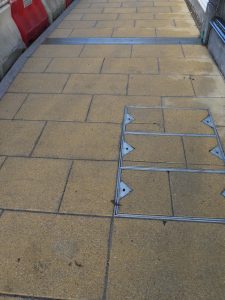New Pavement in Fisherton Street
The Fisherton Gateway project
Wiltshire Council has received £8.5 million from the government’s Future High Streets Fund, which was set up to promote town centres and retail activity within them. £5.3 million will be spent on the railway station forecourt and £3.2 million on the Fisherton Gateway, which is effectively South Western Road and Fisherton Street, up to Malthouse Lane. No consultation was carried out on the overall apportionment of the money, but there was consultation in 2022 about the details of the work on both projects. The Civic Society put a lot of work into considering the proposals and coming up with a response. It had considerable reservations about the Fisherton Street scheme, and in particular a lack of any real ambition to improve the balance between motorised transport and pedestrians and cyclists. It did not however query the choice of materials, which saw a considerable emphasis on granite for paved areas.
In February 2023 the Society was shown the current working drawings for both the Fisherton Gateway and station forecourt schemes, which still had natural stone as the main paving material, though it had changed from granite to York stone. This is a traditional urban paving stone, much used already in the city for street enhancement works, for instance in Blue Boar Row and Queen Street.
When work actually started on putting down new pavements in Fisherton Street, in autumn 2023, it was therefore something of a shock to find that what was going down was not natural York stone, but an artificial concrete paver in a yellowish hue. Quite a few people will no doubt prioritise their relief that uneven and badly maintained surfaces are a thing of the past in the street, over the visual impact of the change, but the Civic Society is inevitably going to consider that aspect as well. While it would have preferred a different overall approach to Fisherton Street, it appreciated that what Wiltshire Council came up with was still going to significantly improve things – as long as the commitment to good quality materials was seen through. That it hasn’t been is a sore disappointment.
The Civic Society has expressed its concern to the Council not only about the change of paving material, but also about the complete failure to consult about this. If the Council had told people about the financial situation apparently not making York stone possible, there could have been discussions about, for instance, reducing the geographical spread of the work in order to maintain the quality of materials. There might well have been reasons why one idea, that of omitting South Western Road from the work and doing a higher quality job elsewhere, could have been shown not to be viable, but no chance was ever provided to consider this or other ideas.
If the Council’s case for moving to concrete pavers had to be reluctantly accepted, there still could have been very useful consultation about which type and colour of such pavers would work best, from the very large range which is available. Now it seems that the decision was a fait accompli some time ago, and South Western Road and the station forecourt, the scheme for which shows large areas of paving, will have the same yellowish pavers imposed on them.
No satisfactory reply has come from Wiltshire Council to the Civic Society’s letter, and realistically there’s probably little the Council can say. What is by far the largest investment in the city’s public realm since the Market Place project of around 2014 has, in the Society’s view, been devalued by a fundamental decision which could have been consulted on, but wasn’t.



